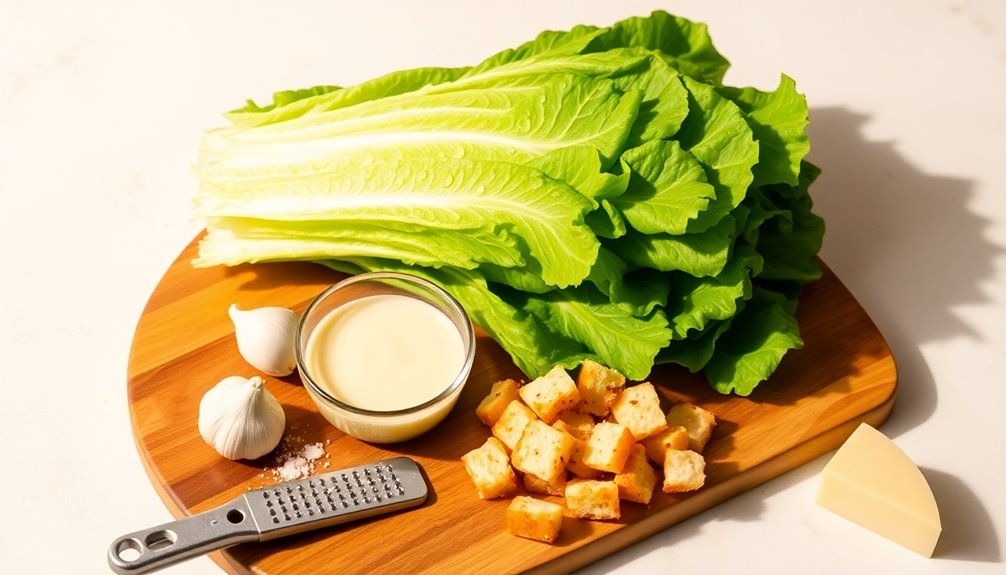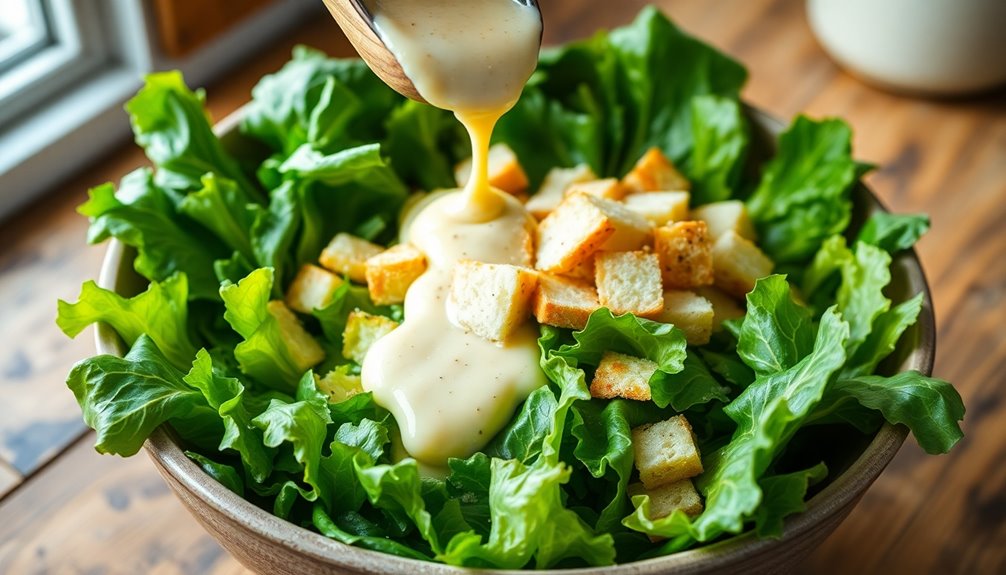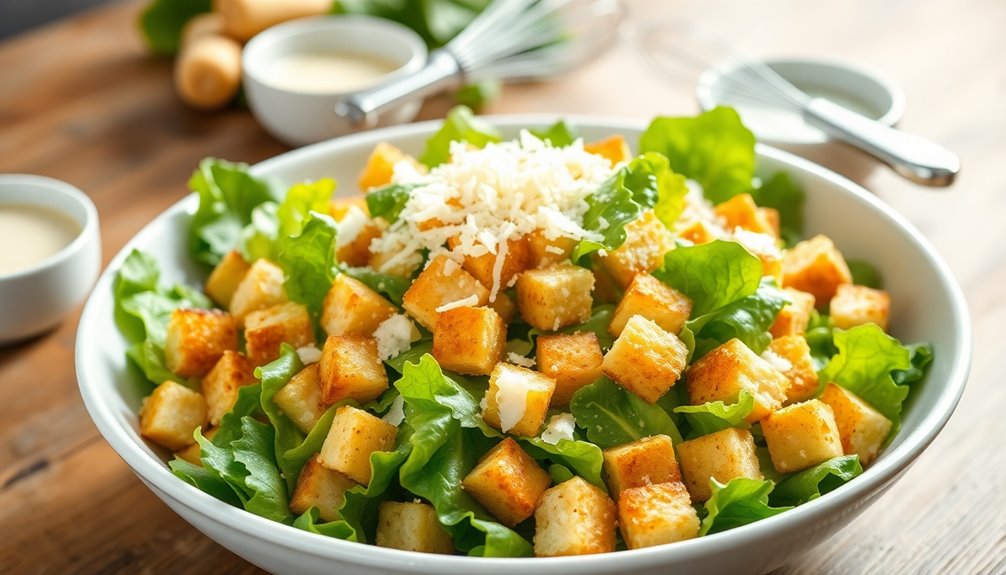You'll love making a classic Caesar salad, inspired by creativity in the 1920s. Start with a large head of crisp romaine lettuce. Wash and tear it into bite-sized pieces. For your dressing, mix ½ cup of mayonnaise with 2 tablespoons of lemon juice, 1 teaspoon of Dijon mustard, minced garlic, salt, and pepper. Toss the lettuce in the dressing and top with ½ cup of grated Parmesan and 1 cup of crunchy croutons. Serve immediately for the best taste. And wait—you might be curious about some tasty variations or tips to elevate your salad game!
Key Takeaways
- Caesar Salad originated in the 1920s in Tijuana, Mexico, and features romaine lettuce, croutons, and a creamy dressing.
- Key ingredients include romaine lettuce, croutons, grated Parmesan cheese, mayonnaise, lemon juice, Dijon mustard, garlic, salt, and pepper.
- To prepare, wash and tear lettuce, mix in dressing, and toss with Parmesan and croutons before serving.
- The salad can be customized with grilled chicken, shrimp, or roasted vegetables for added flavor and nutrition.
- Serve immediately to maintain the freshness and crunchiness of the salad ingredients.
History

The history of the Caesar salad is quite fascinating, as it's believed to have originated in the 1920s in Tijuana, Mexico.
You mightn't know that it was created by Caesar Cardini, an Italian-American restaurateur, who crafted this dish on a busy Fourth of July weekend. With limited ingredients, he combined romaine lettuce, croutons, Parmesan cheese, and a unique dressing made from egg, garlic, and anchovies.
People quickly fell in love with its bold flavors and fresh ingredients. As you explore its journey, you'll find that the Caesar salad gained popularity in the United States during the mid-20th century.
Today, it's a staple on menus worldwide, often enjoyed in various interpretations while still honoring its original roots.
Recipe

Caesar salad is a classic dish that combines crisp romaine lettuce, creamy dressing, and crunchy croutons, all topped off with a sprinkle of Parmesan cheese. Its origins can be traced back to the 1920s in Tijuana, Mexico, where it was invented by Caesar Cardini, an Italian-American restaurateur.
This timeless salad is perfect as a side dish or a light meal on its own, and it's beloved for its rich flavors and satisfying textures.
Making a Caesar salad at home is simple and requires just a few fresh ingredients. The key to a delicious Caesar salad lies in the dressing, which can be made from scratch to guarantee the best taste. With just a little preparation, you can whip up this delightful dish in no time to impress your family and friends at your next gathering or simply enjoy it on a cozy night in.
Ingredients:
- 1 large head of romaine lettuce
- 1 cup croutons
- 1/2 cup grated Parmesan cheese
- 1/2 cup mayonnaise
- 2 tablespoons lemon juice
- 1 teaspoon Dijon mustard
- 1 clove garlic, minced
- Salt and pepper to taste
- Optional: Anchovies for garnish
To prepare the Caesar salad, start by washing and drying the romaine lettuce thoroughly. Tear the leaves into bite-sized pieces and place them in a large salad bowl.
In a separate bowl, whisk together the mayonnaise, lemon juice, Dijon mustard, minced garlic, salt, and pepper until smooth to create the dressing. Pour the dressing over the lettuce and toss gently to coat the leaves evenly.
Add the croutons and grated Parmesan cheese on top, and give it another light toss. If you like, add anchovies for an extra layer of flavor.
When making a Caesar salad, freshness is key. Use crisp romaine lettuce and freshly grated Parmesan cheese for the best taste.
Additionally, feel free to customize your salad by adding grilled chicken, shrimp, or even roasted vegetables for a heartier meal. Adjust the amount of dressing to your preference, and remember that the salad is best enjoyed immediately after preparation to maintain the crispness of the lettuce and croutons.
Cooking Steps

To make your Caesar salad shine, start by washing and drying the romaine lettuce.
Once it's clean, tear it into bite-sized pieces for the perfect texture.
Next, you'll want to add the dressing and toss everything together before adding the Parmesan and croutons—serve immediately for the best freshness!
Step 1. Wash and Dry Romaine Lettuce

Start by carefully rinsing your romaine lettuce under cold running water to remove any dirt or grit.
Make certain to separate the leaves slightly as you rinse to guarantee all surfaces are clean.
Once you've washed the lettuce thoroughly, shake off the excess water.
To dry it effectively, you can use a salad spinner. Place the rinsed leaves in the spinner and spin until they're dry.
If you don't have a salad spinner, gently pat the leaves with a clean kitchen towel or paper towels.
Removing excess moisture is essential, as wet lettuce can make your Caesar salad soggy.
Now that your romaine is clean and dry, you're ready for the next steps in preparing your delicious salad!
Step 2. Tear Lettuce Into Bite-Sized Pieces

Tear the clean, dry romaine lettuce into bite-sized pieces, guaranteeing each piece is manageable for eating.
Start from the base of the leaves, pulling them apart gently to maintain their crispness. Aim for pieces about two to three inches in size; this makes it easier to mix and enjoy later.
If you prefer a more rustic look, don't stress about uniformity—just keep it consistent enough to guarantee a pleasant bite.
Avoid cutting the lettuce with a knife, as this can bruise the leaves and affect their texture.
Once you've finished tearing, place the pieces in a large bowl, ready for the next steps in creating your delicious Caesar salad.
Enjoy the fresh crunch!
Step 3. Add Dressing and Toss

Drizzle the Caesar dressing over the torn lettuce, ensuring each piece gets a generous coating.
Use tongs or a large fork to gently toss the lettuce and dress it evenly. You want every leaf to be coated without tearing them apart.
If you feel the salad's a bit dry, add a little more dressing until it reaches your desired taste. Don't be afraid to taste as you go; this helps you get it just right.
Once the lettuce is nicely dressed, take a moment to appreciate the creamy, tangy aroma wafting up. This step is essential because it sets the stage for the flavors to meld together beautifully.
Now you're ready for the next delicious additions!
Step 4. Add Parmesan and Croutons

Once you've tossed the lettuce with dressing, sprinkle a generous amount of freshly grated Parmesan cheese over the top.
Make sure to cover the greens evenly, allowing the rich, nutty flavor of the cheese to meld with the dressing.
Next, grab your croutons—either store-bought or homemade—and scatter them over the salad.
These crunchy bites add texture and enhance the overall taste.
If you like, you can toss the salad gently again to distribute the cheese and croutons more evenly.
Don't be afraid to add more Parmesan or croutons if you prefer a heartier salad.
Just remember, the goal is to achieve a delicious balance of flavors and textures that'll make every bite enjoyable.
Enjoy your masterpiece!
Step 5. Serve Immediately for Freshness

To guarantee your Caesar salad retains its crispness and vibrant flavors, serve it immediately after tossing. Once you've mixed in the Parmesan and croutons, it's essential to plate the salad right away.
Waiting too long can lead to soggy greens and wilted toppings, dulling the fresh taste you've worked hard to achieve.
As you serve, consider adding an extra sprinkle of Parmesan or a few more croutons on top for a tempting presentation.
If you're dining with others, let them know the salad's best enjoyed fresh to elevate the experience.
Final Thoughts

As you wrap up your culinary adventure with this Caesar salad recipe, remember that the key to a great dish lies in fresh ingredients and your personal touch.
Don't be afraid to experiment; add grilled chicken for protein, or toss in some roasted veggies for extra flavor. The beauty of Caesar salad is its versatility, allowing you to cater to your taste preferences.
Make sure to serve your salad immediately for that perfect crunch, and consider pairing it with a nice glass of white wine for a complete meal.
Finally, enjoy the process! Cooking should be fun and rewarding. So, gather your loved ones, share your creation, and savor every bite. Happy cooking!
Frequently Asked Questions
Can I Use Gluten-Free Croutons in My Caesar Salad?
Absolutely, you can use gluten-free croutons in your salad!
They'll add that delicious crunch without the gluten. Just make sure to check the packaging for any hidden gluten ingredients, as some brands might include them.
You'll find plenty of tasty options available, so you won't have to compromise on flavor.
Enjoy your salad with those crispy croutons, and you'll still get that satisfying texture you love, minus the gluten!
What Can I Substitute for Anchovies in the Dressing?
If you're looking to substitute anchovies in your dressing, there are several tasty options.
You can use Worcestershire sauce, which has a similar savory depth, or try miso paste for a rich, umami flavor.
For a vegetarian option, consider using capers or even a bit of soy sauce.
Just remember to adjust the quantities to suit your taste, and you'll still achieve that delicious, tangy dressing you're aiming for!
How Long Does Homemade Caesar Dressing Last in the Fridge?
Homemade dressing usually lasts about a week in the fridge.
To keep it fresh, store it in an airtight container and make sure it's properly sealed.
If you notice any changes in smell, taste, or appearance, it's best to toss it.
You can also extend its shelf life by using fresh, high-quality ingredients and keeping it chilled right after making it.
Enjoy your dressing while it's at its best!
Is Caesar Salad Safe for Pregnant Women to Eat?
Yes, Caesar salad can be safe for pregnant women, but you need to be cautious.
The main concern is raw eggs in the dressing, which can pose a risk of salmonella. If you're using a pasteurized egg product or a store-bought dressing without raw eggs, you should be fine.
Always verify your ingredients are fresh and properly washed to minimize any foodborne illness risk.
Enjoy your salad, but stay informed!
Can I Make a Vegan Version of Caesar Salad?
Absolutely, you can make a vegan version of Caesar salad!
Start by using a mix of fresh greens like romaine or kale.
For the dressing, blend soaked cashews, lemon juice, garlic, nutritional yeast, and a splash of plant-based milk for creaminess.
Toss in some croutons made from whole grain bread and sprinkle with vegan Parmesan or toasted seeds for added flavor.
You'll enjoy a delicious and satisfying salad that's entirely plant-based!










